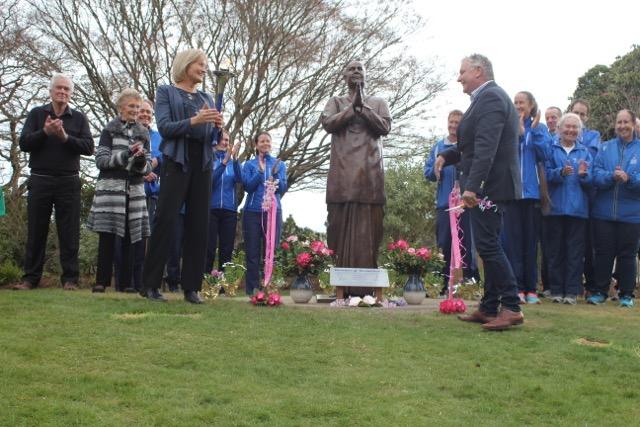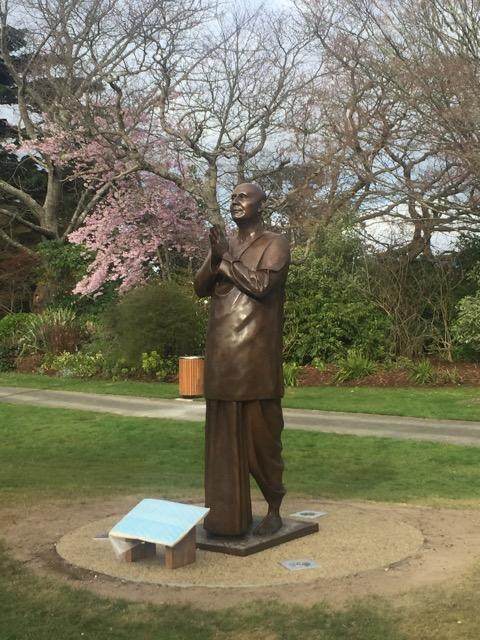New Zealand’s cities and landscapes are dotted with statues, artworks and monuments celebrating our short but eventful history. In civic squares, on roadsides and highways and across parklands and paddocks you’ll see them, the memorabilia of wars; monuments to our deceased founders; rural images of giant gumboots, shearers crouched over iconic sheep and frozen in bronze, giant kiwis, cows, sheep dogs, mounted equestrians; Maori carvings; Greek and Hindu gods and religious monuments; famous All Blacks and poets; Antarctic explorers, giant meditating Buddhas and leaping trout.
They celebrate our great achievers, the sacrifices of soldiers, notable shipwrecks, political luminaries, our unique culture and the way we see ourselves, the human imagination itself.
Memorials and public art represent our values and our view about who and what should be remembered in New Zealand, part of the narrative of our nation’s journey and identity. Our understanding of the past ― our selective celebration of it through our artworks ― also helps to determine our choices as to the future. And here our choice of statues and monuments can undertake a deeper purpose, encouraging reflection about a better world and inspiration about our individual role in fostering this. Our bronze generals on horseback and our Anzac fields filled with the white crosses of the fallen are worthy and meaningful, saluting the dead and remembering the sad lessons of history, but art also needs to look forward towards a brighter future for humanity, one free of the blight of war and suffering. In this way, our public monuments can be profoundly important.
Taupo recently embraced this positive concept of inspirational, interactive art by installing and unveiling a life size sculpting titled ‘Dreamer of World Peace’. The bronze work was created by the noted English sculptor Kaivalya Torpy and commemorates Taupo’s 1993 dedication to peace, a proclamation issued by former mayor Joan Williamson and district councilors of that time. The October unveiling, attended by councilors, peace advocates, schoolchildren, national athletes and iwi representatives, marked the 25th anniversary of that dedication.
The commemorative statue is modelled after the late peace visionary Sri Chinmoy, who founded the 150 nation Peace Run and dedicated his own life to world peace. Sri Chinmoy visited NZ on four occasions and met successive Prime Ministers, founding a legacy of peace initiatives around our nation. Over 12,000 people attended his many free Peace Concerts in New Zealand. He personally visited Taupo for 12 days in 2002, meeting some of its famous locals including rugby great Colin ‘Pinetree’ Meads.

Taupo is the first location in New Zealand to install the popular statue, and joins nearly 30 towns and cities around the world that have embraced this artwork – an international family of peace monuments in India, Russia, the United states, all across Europe and in three cities in Australia. The occasion saw a host of out-of-town visitors, including former New York and Boston marathon winner Allison Roe.
Taupo event co-organiser Muslim Badami commented: “In a world where humankind is confronted with so many pressing challenges, it’s heartening to focus on the positives and to remind ourselves of the power we each have in our individual lives to help in building a better world. And this is the message of the statue – that we are each peace makers, bridge-builders and harmony dreamers, and that world peace starts with each one of us in our own lives.
The statue is intended as an interactive public artwork that invites everyone’s participation. You’ll be amazed at how much people respond to it! The folded hands are a traditional gesture of welcome and they say to each visitor ‘I greet you, I bow to the peace-lover in you’. This wonderfully expresses our own community’s welcome to our thousands of visitors and guests. The folded hands are also a prayer or request to a higher power, however we choose to imagine that, to bring down peace into our troubled world.”
“The statue has a lovely stillness and presence and provides a focal point in our parkland and our community for reflection and peace. It inspires us to understand that we each truly matter, that a peaceful world requires peaceful people, that a brighter future for humanity can only be founded upon our individually peaceful lives. ‘Dreamer of World Peace’ is in fact all about you and me and how much we matter. “
Reprint with the kind permission of NZ Indian Outlook\ by Jogyata Dallas
